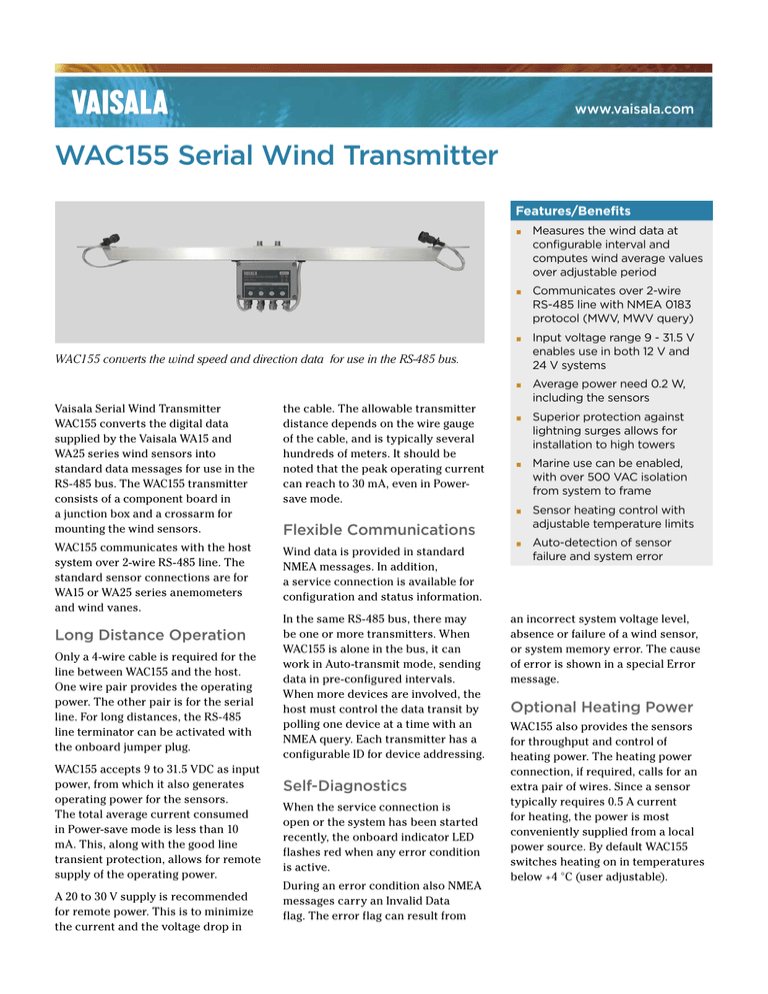
www.vaisala.com
WAC155 Serial Wind Transmitter
Features/Benefits
▪
Measures the wind data at
configurable interval and
computes wind average values
over adjustable period
▪
Communicates over 2-wire
RS-485 line with NMEA 0183
protocol (MWV, MWV query)
▪
Input voltage range 9 - 31.5 V
enables use in both 12 V and
24 V systems
▪
Average power need 0.2 W,
including the sensors
▪
Superior protection against
lightning surges allows for
installation to high towers
▪
Marine use can be enabled,
with over 500 VAC isolation
from system to frame
▪
Sensor heating control with
adjustable temperature limits
▪
Auto-detection of sensor
failure and system error
WAC155 converts the wind speed and direction data for use in the RS-485 bus.
Vaisala Serial Wind Transmitter
WAC155 converts the digital data
supplied by the Vaisala WA15 and
WA25 series wind sensors into
standard data messages for use in the
RS-485 bus. The WAC155 transmitter
consists of a component board in
a junction box and a crossarm for
mounting the wind sensors.
the cable. The allowable transmitter
distance depends on the wire gauge
of the cable, and is typically several
hundreds of meters. It should be
noted that the peak operating current
can reach to 30 mA, even in Powersave mode.
WAC155 communicates with the host
system over 2-wire RS-485 line. The
standard sensor connections are for
WA15 or WA25 series anemometers
and wind vanes.
Wind data is provided in standard
NMEA messages. In addition,
a service connection is available for
configuration and status information.
Long Distance Operation
Only a 4-wire cable is required for the
line between WAC155 and the host.
One wire pair provides the operating
power. The other pair is for the serial
line. For long distances, the RS-485
line terminator can be activated with
the onboard jumper plug.
WAC155 accepts 9 to 31.5 VDC as input
power, from which it also generates
operating power for the sensors.
The total average current consumed
in Power-save mode is less than 10
mA. This, along with the good line
transient protection, allows for remote
supply of the operating power.
A 20 to 30 V supply is recommended
for remote power. This is to minimize
the current and the voltage drop in
Flexible Communications
In the same RS-485 bus, there may
be one or more transmitters. When
WAC155 is alone in the bus, it can
work in Auto-transmit mode, sending
data in pre-configured intervals.
When more devices are involved, the
host must control the data transit by
polling one device at a time with an
NMEA query. Each transmitter has a
configurable ID for device addressing.
Self-Diagnostics
When the service connection is
open or the system has been started
recently, the onboard indicator LED
flashes red when any error condition
is active.
During an error condition also NMEA
messages carry an Invalid Data
flag. The error flag can result from
an incorrect system voltage level,
absence or failure of a wind sensor,
or system memory error. The cause
of error is shown in a special Error
message.
Optional Heating Power
WAC155 also provides the sensors
for throughput and control of
heating power. The heating power
connection, if required, calls for an
extra pair of wires. Since a sensor
typically requires 0.5 A current
for heating, the power is most
conveniently supplied from a local
power source. By default WAC155
switches heating on in temperatures
below +4 °C (user adjustable).
Technical Data
Performance
Signal Inputs and Outputs
Measurement range:
Speed
Direction
Measurement frequency:
Speed
Direction
Averaging interval
Updating interval
Resolution:
Speed
Direction
0 … 75 m/s
0 … 360°
4 Hz
32 Hz
0.25 … 5 s (default 3 s)
0.25 s
0.1 m/s
2.0° (by averaging the 8 samples
in each 0.25 s period)
Power Inputs and Outputs
Input operating voltage
9 … 31.5 VDC
Input operating current at 24V:
Power-save enabled
7 mA (incl. both sensors)
Power-save disabled
37 mA (incl. both sensors)
Heating control, WA15
On at 3 °C / Off at 5 °C (adjustable)
Heating voltage, WA15:
Parallel connection
16 ... 24 VDC or VACrms
Series connection
32 .... 48 VDC or 32 .... 43 VACrms
Heating current, WA15:
Parallel connection
1.0 A at 20 V (incl. both sensors)
Series connection
0.5 A at 40 V (incl. both sensors)
Heating for WA25
Passed by w. expansion connector
Signal input:
From wind vane
From anemometer
Data transmission i/o:
Type
Rate & frame, default
Rate & frame, adj. range
Message protocol
Operating temperature
Storage temperature
Humidity
Dimensions:
Junction box (w × h × d)
Crossarm + Junction box (w x h x d)
Weight
Ingress protection
Mounting
Materials
Wind Vane
HTNG LGN
GND BLU
WAC155
YEL HTNG
C
GRN Fout
X1
BLU GND
12345
1 2 3 4 5 6 7 8 9 10
HTC
HT2
GND
D+
G5
G4
G3
G2
G1
G0
G5 GRN
D
F
F+
GND
HT1
HTC
B
RED F+
127 × 110 × 58 mm
887 x 165 x 157 mm
1.5 kg
IP65
To Ø 60 mm pole mast
Aluminum
D+ RED
WHT HTNG
A
-55 … +60 °C
-60 … +70 °C
0 … 100 %RH
Dimensions and Materials
BLK SPARE
E
2-wire, half-duplex RS-485
9600, 8N1
300 … 19200, 7/8, O/E/N, 1/2
NMEA 0183 / MWV, MWV query
Operating Conditions
Anemometer
F
6-bit GRAY code (0.5/10.5 V)
0 … 750 Hz sq. wave (0.5/10.5 V)
X2
G4 YEL
X3
G3 WHT
G2 VIO
D C B
J
A
E
K
F G H
G1 ORN
G0 PNK
HTNG GRY
Cable ZZ45036
Cable ZZ45037
Please contact us at
www.vaisala.com/requestinfo
www.vaisala.com
Ref. B210672EN-A ©Vaisala 2013
Scan the code for
more information
This material is subject to copyright protection, with all
copyrights retained by Vaisala and its individual partners. All
rights reserved. Any logos and/or product names are trademarks
of Vaisala or its individual partners. The reproduction, transfer,
distribution or storage of information contained in this brochure
in any form without the prior written consent of Vaisala is strictly
prohibited. All specifications — technical included — are subject
to change without notice.




